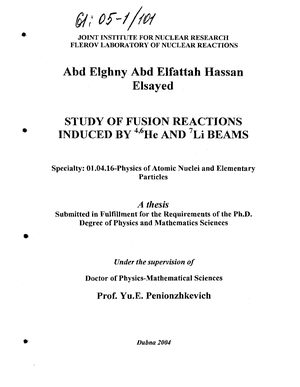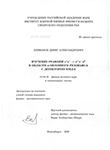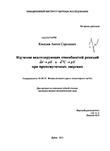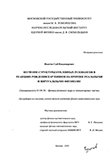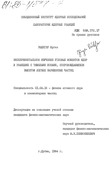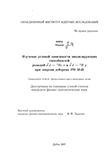Содержание к диссертации
Введение
1 Experimental and Theoretical Situations
1-1 Experimental situations for study of fusion reactions with exotic
nuclei:
1-1-1 Cross section for fusion-fission reaction
1-1-2 Cross section for fusion-evaporation reaction
1-1-3 Conclusion 1-2 Theoretical predictions for study of fusion reactions with exotic nuclei :
1-3 Conclusions
2 Experimental Procedures
2-1 Beam production
2-2 Beam monitoring and energy measurement
2-3 Setup for on-line measurements of fission and evaporation cross sections
2-4 Experimental procedure for off-Line measurements of evaporation
channel cross sections
3 Experimental Results
3.1 Fission and evaporation cross section measurements in the reactions 4He+209Bi and 6He+209Bi
3.2 Fission and evaporation cross section measurements in the reactions 7Ii+208Pb and 7Li+209Bi
4 Experimental Results Analysis
Conclusions
References
- Cross section for fusion-fission reaction
- Conclusion 1-2 Theoretical predictions for study of fusion reactions with exotic nuclei
- Setup for on-line measurements of fission and evaporation cross sections
- Fission and evaporation cross section measurements in the reactions 7Ii+208Pb and 7Li+209Bi
Введение к работе
The study of fusion reactions near and above the Coulomb barrier involving weakly-bound or radioactive beams are one of the most challenging experimental and theoretical problems in nuclear physics. It is well established that the coupling of collective degrees of freedom to the fusion channel enhances significantly the tunneling probability at sub-barrier energies [1]. On the other hand, the low binding energy of radioactive nuclei may cause important loss of incoming flux due to the breakup process.
Several experimental and theoretical studies concerning the fusion of two nuclei under and near the Coulomb barrier were performed in the past [2]. Most of the results were interpreted adequately well within the framework of coupled-channel (CC) calculations and by using either microscopic potentials or phenomenological ones [3,4]. With the advent of radioactive beam facilities, the interest in such studies with halo nuclei was renewed due to their specific features, like extended neutron densities, low-lying continuum, and also very low-energy thresholds for breakup. Fusion, like other reaction processes, should be appreciably affected by such features. The experimental results obtained for fusion reactions at energies close to the Coulomb barrier with light unstable beams were reviewed by C. Signorini [5]. The data point out a strong influence due to breakup processes.
From a theoretical point of view, it is expected that fusion cross sections for halo nuclei will present an increase due to the decrease of the potential barrier and the coupling to soft vibrational modes [6]. This increase, however, according to several elaborate but contradictory theories, may be hindered or enhanced due to breakup effects.
In different scientific centers, intensive experimental studies are performed using secondary beams formed from the radioactive products of nuclear reactions. Lately there has been a growing trend to use secondary beams as a means of investigating the interaction cross sections of these exotic nuclei with the target nuclei. These data help getting information on the structure of nuclei far from the line of stability, on the distribution of nuclear matter and on charge radii. However, for unequivocal conclusions there is a question on comparison of these reactions with the reactions caused by particles of a stable beam nucleus.
Several measurements with halo nuclei were visualized through the systems nBe+209Bi [7], 6He+209Bi [8-Ю], and 6He+238U [11]. The data are presented in Fig. I together with the data of the associated stable isotopes W209Bi [7], 4He+209Bi [12] and 4He+238U [11].
For energies around the coulomb barrier the cross sections for the fusion of 4,6He on 209Bi and 23SU targets present the same behaviour. That is the cross sections with halo projectiles are enhanced over the cross sections with the stable ones. The fusion cross section for the halo nucleus 6He on 238U and 209Bi targets is enhanced over that of 4He for energies around barrier, but no such enhancement is observed for the fusion of the ] e on 209Bi over that of 9Be.
Fusion measurements with radioactive beams of 6He and nBe do not show a fusion suppression above barrier energy. In contrast, measurements of the stable, but weakly bound 9Be with 208Pb [13], 6 7Li with 209Bi [14] and 7Li with 165Ho [15] showed that there is an enhancement below the barrier and suppression above the barrier.
The main goal of the present work is the attempt to reveal any peculiarities that might manifest themselves in reactions induced by weakly bound light nuclei.
One way to do this is to measure the fission and evaporation residue cross sections for one and the same composite nucleus, produced in different target-projectile combinations
Cross section for fusion-fission reaction
Understanding the reaction mechanisms for unstable nuclei will help in the production of new nuclei far from the line of stability. One question which has generated much controversy [26] is how the weakly bound nature of nuclei affects the fusion process. In particular what role is played by dynamical coupling effects? Fusion studies using stable beams have shown [27] that coupling between the relative motion of the colliding nuclei and their intrinsic degrees of freedom results in enhancement of fusion cross-sections at energies below the Coulomb barrier. Thus, for loosely bound nuclei too, couplings to intrinsic states may be expected to give rise to enhancement of fusion cross-sections at sub-barrier energies compared with the expectations of a single barrier calculation. However, due to their weak binding, the low lying states of these nuclei lie above the breakup threshold. If these states are short-lived then the nucleus can break up before reaching the fusion barrier, leading to a reduction in the complete fusion cross-section. Another feature unique to weakly bound nuclei is low-lying continuum states. The couplings to and breakup from these states can cause the fusion of weakly bound nuclei to behave differently from the fusion of tightly bound nuclei. The effect of couplings to both unbound and continuum states have resulted in predictions both of suppression and enhancement compared with single barrier penetration model predictions. It is now becoming clear that the effect on fusion should be decided by the competition between enhancement due to coupling effects and reduction due to breakup of the projectile, which results in reduced flux reaching the barrier.
There have been a variety of pervious experiments performed to study the fusion mechanism with neutron rich nuclei. In most cases these experimental studies of the fusion reactions induced by exotic nuclei were concentrated on the fusion-fission and fusion-evaporations cross section measurements.
Cross section for fusion-fission reaction: Experiments with loosely bound unstable nuclei like 6He and nBe have concentrated on fusion-fission with lugh-Z targets and at energies near the barrier comparing with the data of the associated stable isotopes like (9Be, 4He).
The nuclear structure has a strong influence on the fusion- fission cross section at near barrier energies. A first experiment to measure near and sub-barrier fusion cross sections for the systems 9Be and nBe on a 238U target was performed at GAML by V. Fekou-Youmbi et al. [27] where the one neutron halo effect on fusion-fission was investigated. However the fission cross sections extracted in this first measurement suffer from the low statistics and do not allow clear conclusions as shown in Fig. 1-1.
The fission with the halo nucleus He projectiles has been investigated the first time by AS. Fomichev et al. [9] by studying the fission reaction induced by 6He on 209Bi at Ecm 1.5VB where VB is the barrier height. They found that the fission excitation function for 6He is 3 times larger than for He ions in the whole energy range. The fusion-fission cross sections for the halo nucleus 6He on 209Bi targets are large enhanced over that of 4He for energies above barrier, and do not show fusion suppression at above barrier energies (see Fig. I).
M. Trotta et al. [12] measured the fusion-fission cross sections of the He+ U and He+ U systems for energies around and below the Coulomb barrier. They found that at the barrier no hindrance due to the breakup of the nucleus is observed, and below the barrier there is a large enhancement of the fusion probability for the 6He nucleus with respect to the stable 4He nucleus (see Fig. I).
J.L. Sida et al. [28] measured the effect of the halo on the fusion-fission probability above and below the barrier for the system 4,6He+238U. At the barrier, when comparing to other data for A 6 isobars, the fusion cross sections do not have a clear trend as seen for the A=4 nuclei. Below the barrier, there is a large enhancement of the cross sections for the 6He nucleus with respect to the stable 4He nucleus as shown in Fig. 1-2. A further experiment is needed to disentangle the real fusion-fission component in the fission cross section.
Conclusion 1-2 Theoretical predictions for study of fusion reactions with exotic nuclei
N. Takigawa et al. [43] investigated the fusion reaction of the exotic halo nucleus ] Li on 208Pb using a semiclassical formula of the fusion cross section which takes the effect of breakup into account via local dynamic polarization potential. They showed that the effect is not so large and that a halo nucleus is still expected to lead to a much larger fusion cross section than other nuclei. The enhancement was predicted to occur for a wide range of bombarding energies and becomes especially larger at low energies as shown in Fig. 1-15.
Fig. 1-15: Comparison of the fusion cross section of Li isotopes with 208Pb. The line with open circles is that for the uLi induced reaction. The other lines are for the other Li isotopes [43]. C.H. Dasso et al. [44]. They was examined the effect on the couplings on the fusion cross section in the reaction uLi+208Pb leading to 21?At. The coupled-channel calculations which they used have been done by considering two uLi channel corresponding to the ground state and the low-lying dipole mode, and a third channel for 9Li; associated with the breakup process. The inclusion of this process leads to a further enhancement of the fusion cross section as shown in Fig. 1-16. 26 30 26 30
Fig. 1-16: Fusion cross section for nLi+208Pb as a function of bombarding energy, (a): Fusion cross section leading to the formation of 219At, (b): Total cross section for the formation of astatine (solid) together with the separate contribution from 2iyAt (dashed) and 217At (dotted) [44].
It has been known for some time that the sub-barrier fusion of stable nuclei can be enhanced by several orders of magnitude beyond expectations from simple one-dimensional barrier penetration calculations. A qualitative understanding of this phenomenon has been achieved in terms of couplings to internal degrees of freedom of the target and projectile [34], resulting in a lowering of the effective fusion barrier. This dynamical effect is a very sensitive probe of the nuclear structure of colliding partners. The lowering of the barrier, by 20% or more, is also a general feature in the results for uLi+208Pb fusion presented in [8, 11, 14, 18-20], but the leading effect that was calculated in this case is a static one, resulting from the larger radius of the nLi "halo" wave function which allows the attractive nuclear force to act at longer distances. However, additional dynamical enhancement was obtained from the coupling the soft El mode [8]. The role played by projectile breakup channels, which are possibly important due to the weak binding of the valence neutrons, is considerably more controversial. Several groups [37-39] have reported that coupling to these channels reduces the fusion cross section near the barrier, leading to intriguing structure in the excitation function in this region. However, this point of view has been criticized by Dasso and Vitturi [44] who suggest that it results from a misunderstanding of the nature of multidimensional quantum-mechanical tunneling processes. They report only enhancement of the fusion yield, even in the presence of strong breakup channels. It is important to resolve this controversy since the competition between projectile breakup and sub-barrier fusion enhancement will have important implications for attempts to form superheavy elements via fusion of exotic, neutron rich projectiles [43].
Coupled channels calculations for nBe+208Pb [46] have shown that the coupling of the relative motion to the breakup channel has two effects, depending on the value of the bombarding energy, namely, (i) a reduction of the complete fusion cross sections at energies above the Coulomb barrier due to the loss of incident flux and (ii) an enhancement of the complete fusion cross sections at energies below the Coulomb barrier due to the dynamical renormalization of the nucleus-nucleus potential. Using the isocentrimgal approximation and an incoming boundary condition inside the barrier, this calculation did not include the effect of the projectile s halo structure on the monopole projectilearget potential. Nor did it include the excitation to partial waves other than /?3/2 in the continuum, or the continuum and bound excited states couplings in either reaction partner. Moreover, only a small interval of energy for continuum states (up to 2 MeV) was considered.
The effect of continuum couplings in the fusion of the halo nucleus nBe on 208Pb around the Coulomb barrier is studied recently by A. Diazorres et al., [47] using a three-body model within a coupled discretized continuum channels formalism . They investigate in particular the role of continuum-continuum couplings. These are found to hinder total, complete, and incomplete fusion processes. Couplings to the projectile 1/?1/2 bound excited state redistribute the complete and incomplete fusion cross sections, but the total fusion cross section remains nearly constant. Results show that continuum-continuum couplings enhance the irreversibility of breakup and reduce the flux that penetrates the Coulomb barrier. Converged total fusion cross sections agree with the experimental ones for energies around the Coulomb barrier, but underestimate those for energies well above the Coulomb barrier see Fig. 1-17. Em fjfeSeV Fig. 1-17: Fusion cross sections as a function of the bombarding energy in the center of mass system for uBe+208Pb. (a) Include only couplings from and to the nBe bound states, (b) Couplings between all uBe excited states (continuum-continuum) are included. The arrow indicates the Coulomb barrier for the elastic channel [47].
The near-barrier and sub-barrier fusion of light unstable nuclei and their respective stable isotopes with heavy targets (4 6He+209Bi, 4 6He+238U, 9Д1Ве+209Ві, and 9Be+20 Pb) is investigated via coupled channel calculations by N. Alamanos et al., [48]. It was found that a fundamental difference occurs between stable and unstable systems. The dominant channel in the barrier energy region of stable systems is fusion (see Fig. [(1-18), (1-19)]). For unstable and weakly bound nuclei this is not the case (see Fig. 1-20) . Losses of the flux through other channels like breakup take place, and can be taken into account by the reduction of the real part of the entrance channel optical potential, i.e., exactly in the same way as for elastic-scattering data. In that respect, the description of the weakly bound systems (9Ве+Ї09Ві), (9Be+208Pb) and the halo systems (6He+209Bi), (%e+238U), and (nBe+209Bi) were adequately obtained, by making use of a reduced potential to account for the breakup processes. Although for the weakly bound systems this description was excellent, for the halo systems only a qualitative agreement was obtained. More elaborate theoretical approaches and additional measurements including elastic scattering, complete fusion (without contributions due to incomplete fusion) and breakup are necessary, in order to obtain a more comprehensive picture of near-barrier and sub-barrier fusion, involving halo nuclei.
Setup for on-line measurements of fission and evaporation cross sections
A schematic view of the experimental setup is presented in Fig. [(2-8), (2-9)]. The setup has been built for detecting both evaporation residues and fission fragments in the reactions induced by a neutron rich exotic nuclei in parallel. The setup can hold up to three targets. The targets are placed at 45" with respect to the secondary beam direction. Two silicon detectors (diameter 5 cm), located with distance 3 cm from the target, face each target from either side. This makes it possible to increase the effective solid angle up to 30% and thus get sufficient statistics in a shorter period of irradiation. This array of three targets allows increasing the statistics by a factor of three, as the maximum energy loss of the beam particles between the three targets is less than 1 MeV. If energy degraders are inserted between the targets, it would be possible to get measurement at three different energies of the beam in one run.
The silicon detectors measure the energy of the a-particles emitted by various evaporation residues and also the energy of the fission fragments. The signals from the silicon detectors are divided for the fission fragments and for the evaporation residuals decay. For this purpose, for each detector channel two spectroscopic amplifiers (operating at various gains) are used as shown in Fig. 3-Ю. Because of the quite large solid angle, this setup is suitable to use in studies of secondary-beam induced reactions as it makes possible the investigation of reactions with cross sections less than lmb at a mean beam intensity of about -10 pps.
This experimental setup has been tested using a 226Ra source for a-particles and 244Cm source for fission fragments. The energy spectrum of the emitted a-particles, measured with one of the detectors, is shown in Fig.2-10 (upper panel) as an example. We observe four peaks, corresponding to the strongest aransitions 4.7843 MeV, 5.4885 MeV, 6.0024 MeV, and 7.6969 MeV in the decay of 226Ra, 222Rn, 218Po, and 214Po respectively. On the basis of this measurement we have been able to determine the energy resolution for a-particles equal to FWHM » 80 keV. The spectrum of the fission fragments is also shown in Fig. 2-10 (lower panel). We can see that the energy distribution for the fission fragments allows distinguishing the two mass groups characteristic for spontaneous fission of the 44Cm isotope.
Fig. 2-10: Energy spectrum of a-particles emitted by a 226Ra source (upper panel) and energy distribution of fission fragments from the spontaneous fission of 224Cm (lower panel). 2-4 Experimental procedure for off-Line measurements of evaporation channel cross sections:
The evaporation channel cross sections were measured off-line by using two different methods of detection based on the particular decay properties of 215_xnAt, which are the residual nuclei following 4n and up to lOn evaporations from the At compound nucleus as shown in Fig. 2-11. 1 The first method based on the measurement of a-particles emitted from the residual nuclei. 2 The second method based on the measurement of the intensities of the low lying y-rays from the residual nuclei.
The At nucleus has a 7.2 h half-life. When it decays, it emits a 5.87 MeV a particle (41.8%) or decays by electron capture (58.2%) to 211Po (half-life of 0.52 s) which emits a 7.45 MeV a- particle. The evaporation of 5n leads to the production of the isotope At (Тш = 8.1 h). With about 99.8% probability it decays by electron capture to 210Po (Ti/2= 138.4 d) and only in 0.18% of the cases undergoes a-decay with an average energy Ea 5.4 MeV. This long parent half-life makes it possible to irradiate the targets, build up a significant amount of At and Po in the targets, and then determine the production cross section by counting the a-decay rate off-line. Fig. 2-11 Part from the chard nuclei of At-isotopes produced in the reactions 4 6He+209Biand7Li+206Pb. Special "sandwichype" piles from targets and aluminum degraders to vary the energy of the beam were manufactured and irradiated by the beam. Then, the targets were separated and placed in low background a-decay spectrometers with solid angle 3.63 sr to count the emitted a-particles. The ot-activity of these targets was simultaneously measured by semiconductor detectors with resolution for a-particles about 100 keV. The detecting time was longer than a few periods Тід ( At). Before irradiation, each of the targets was also counted to establish the background a-activity levels.
A schematic diagram of the targets, degraders, and monitor detectors is shown in Fig. 2-12.
The energies of the incident beam on a specific target were determined by the energy loss into the aluminum degraders placed just before it. The code LISE [49] was used to estimate the energy loss. The resulting energy straggling (S) of the out coming ion beam from the degrader was considered S 1.2%.
Several factors are required to deduce the 4n and 5n evaporation cross sections from the integrated off-line a-spectra.
First, a normalized number of background counts were subtracted from the integrated counts. The integrated Counts were also corrected for the solid angle, finite counting time (Tm), and the time to transfer the targets from the on-line scattering chamber to the off-line counting system (Tdeiav)- The corrected integrated count values correspond to the number
Second, the number of At and Po atoms present at the end of the irradiation, from off-line counting, gives the 4n and 5n cross section after correcting for the decay of some of the At, 210Po during the irradiation (Tirr). For this, the time structure of the beam intensity, as measured by the count rate of elastically scattered of the beam in the monitor detectors, was used.
Fission and evaporation cross section measurements in the reactions 7Ii+208Pb and 7Li+209Bi
In the analysis of the experimental data and especially in drawing the conclusions of great importance about the fusion fission and fusion evaporation cross sections we should concentrated on the values of the parameters used in the calculations. In calculating the cross sections for reactions with particle evaporation and of fission cross sections for excited nuclei we use two different sets of parameters. One set defines the formation of the compound nucleus and is connected with the geometrical size of the nuclear part of the interaction potential (radius parameter r0) and
its shape (the diffttseness of the potential rfand its depth v). Numerous calculations of compound-nucleus formation cross sections carried for different projectilearget combinations have shown that in all considered cases one can use one and the same set of parameters, viz. rB= 1.3 fin, K = 67 MeV.
The second parameter set defines the competition between the fission and evaporation channels of the formed compound nucleus. These parameters determine the level density in the fission and evaporation channels. In our calculations such parameters were the ratio of the asymptotic values of the level density in the fission and evaporation channels 3/ 3 and Bf the fission barrier which is taken to be constant factor times the rotating liquid drop fission barrier.
Comparing the calculated and experimental excitation functions of the fission and evaporation reactions for a wide range of nuclei a conclusion was drawn that in all cases one can use the fixed value of d/ftdfy= 1.
Moreover, the dependence of the ratio Г„/Г/ on excitation energy, obtained in 22Ne-induced reactions on 194 196 198pt rgrj], has shown that this very value of Щ1 pleads to consistency between experiment and calculations.
Therefore, this parameter was also fixed. Thus, in the analysis of the experimental data there are no free parameters.
A special attention should be also paid to the quantity X r another parameter of importance in the calculations of the fission cross section. This is the critical angular momentum that, at high enough energies (when it becomes less than lmax), determines the number of partial waves leading to the formation of the compound nucleus. As the parameters {ru,v,Щі8/$) stay constant in a wide range of nuclei and Bf varies smoothly with Z and A, one can use for the calculation of the cross sections of a definite reaction the values from any other reaction leading to the formation of compound nuclei lying close by. At the same time the parameter lcri takes different values for different reactions. It is noteworthy that so far there exists no reliable way of calculating lcri. One may only assume, on the basis of very general conceptions about the formation of the compound nucleus, that ka has a square root dependence on energy as well as on the mass of the particles inducing the reaction. However, this is true only if there is no abrupt change of properties (e.g., changes in the radius of the fusion channel, proportional to (л,1"+ 4") when going from one particle to another. I-7Li+20SPb-reaction:
The experimentally measured excitation functions of the reaction 7Li + 208Pb for the 208Pb(7Li, f), 208Pb(7Li, 3«), 208Pb(7Li, 4«), 208Pb(7Li, 5«), 208Pb(7Li, би), 208Pb(7Li, ln\ 208Pb(7Li, 8«) and 208Pb(7Li, 9n) channels, together with the results of calculations are shown in Figs. [(4-2)-(4-4)]. In the theoretical calculations, the only free parameter was lmax. Agreement between the experimental and calculated fission cross sections were obtained for the value of lmax = 35 and TQ (the interaction radius which connected to geometrical size of the nuclear part of the interaction potential) was 1.3 fm. It may be assumed that in the larger part of the considered energy range the number of partial waves leading to the formation of the compound nucleus is defined by the nuclear interaction potential. Good agreements between the experiment results and the fission and evaporation cross sections calculations for the reaction 7Li+208Pb were obtained using the K„=67 MeV. This good agreement showed the possibility to use our approach to calculate reactions induced by such light particles as helium and confirmed the validity of the used set of parameters.

